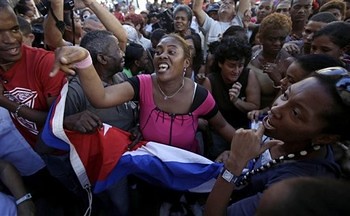
Supporters of Cuba's government chant revolutionary slogans as they argue with members of the Cuban dissident group 'Ladies in White' in Havana, Cuba, Wednesday, Feb. 23, 2011., a photo by Pan-African News Wire File Photos on Flickr.
Havana. August 23, 2012
Women: Pillars of the Revolution
Lisanka González Suárez
Granma International
CUBA was not exempt from denying women their civil and political rights as human beings. Women on the island, like everywhere else, suffered discrimination and injustice, possibly more harshly than their sisters in other nations, given the legacy of machismo left by Spanish colonialism.
The mothers and wives of the Cuban Five
incarcerated in the United States have
shown their strength.
Immediately after January 1959,
women joined the militia to defend
the Revolution.
According to a December 2011 National
Statistics Office study, there are 5.61 million
women in Cuba, almost half of the total
population. They will play a significant role
in the country’s projected development.
In 1883 Cuba had its first doctor and ophthalmologist, Laura Martínez de Carvajal y del Camino, who battled social barriers of the 19th century, to the extent of doing her anatomy practicals on weekends, as the University did not allow her to dissect cadavers with the other students, all male.
Another earlier example (1819) of the long arm of discrimination against women is the story of Enriqueta Faber, of Swiss origin, who was forced to disguise herself as a man, not only to study medicine in France, but to work as a doctor in Cuba.
According to a 1953 census, the majority of women were confined to the home, caring for children and their partners; 13.7% of adult women were employed outside the home, and more than a quarter of these (70,000) were domestic workers, a large percentage of whom were African Cuban. Some were earning barely 20 cents a day, or working solely for a roof over their heads and food.
It is estimated that 83% of all employed women worked for less than 10 weeks a year, and only 14% the year round. The same source recorded that they constituted 82% of teachers, 81% of social workers, and 68% of pharmacists.
The doors to leadership positions or professions considered exclusively male were firmly closed to them. On the other hand, the doors remained open for prostitution, into which many women were forced.
It was only after the January 1, 1959 Revolution that major changes were introduced for Cuban women. Many pioneers of the stature of Haydée Santamaría, Melba Hernández, Celia Sánchez and Vilma Espín played a critical role prior to the revolutionary triumph, in the war or the underground movement, opening the doors to women’s participation in the transformations underway in all areas.
With the creation of the Federation of Cuban Women (FMC) on August 23, 1960, Vilma Espín was responsible for organizing the thousands of women who wished to participate in these changes.
Opportunities soon arrived for involvement in the women’s militia, despite the opposition of fathers or husbands in many cases, when the country was threatened by U.S. imperialism; almost at the same time, thousands of young women trained to teach literacy throughout the country, in the mountains or urban areas. The Ana Betancourt schools were created for girls living in the most remote rural areas, as well as training schools for childcare centers and the [Anton] Makarenko teachers. Step by step, organized and supported by the FMC, women not only demanded their rightful place within society, but set about securing it.
On December 9, 1966, the leader of the Revolution, Fidel Castro affirmed, "This phenomenon of women in the Revolution is a revolution within another revolution. If we were asked what is the most revolutionary thing that the revolution is doing, we would respond that it is precisely this: the revolution which is taking place in the women of our country!"
Many of our forbearers could never have imagined women as bus, truck or tank drivers, directors of sugar mills, vice presidents of government, parliamentary deputies, heads of municipal government, war correspondents, pilots, athletes, sailors and prominent scientists.
It is true that the figures are still below the aspirations of the government, the FMC and women themselves; that traits of machismo remain along with discrimination, particularly in the labor sector; that women themselves could be more assertive in demanding gender equality, but every day sees advances.
This can be confirmed by data from the National Statistics Office. Women comprise 63% of the country’s employed professional and technical personnel; 62.8% of higher education graduates at the end of 2011; 35.6% are in the technical and professional education sector; 36.7% occupy leadership positions; and 43.3% of deputies to the National Assembly of People's Power are women. They constitute 46.7% of the labor force in the state sector, 28% of ministers and 40% of leaders.
No comments:
Post a Comment